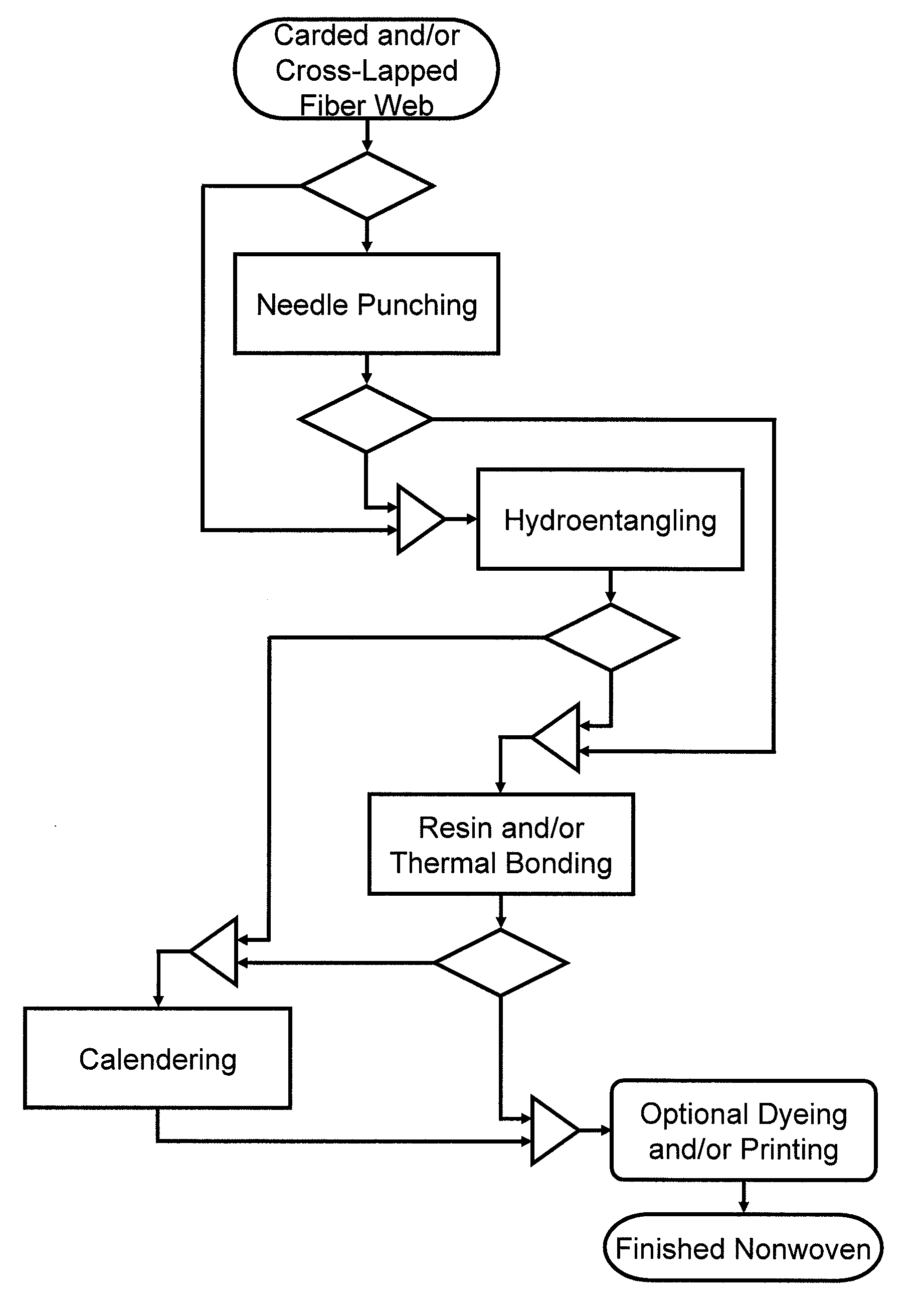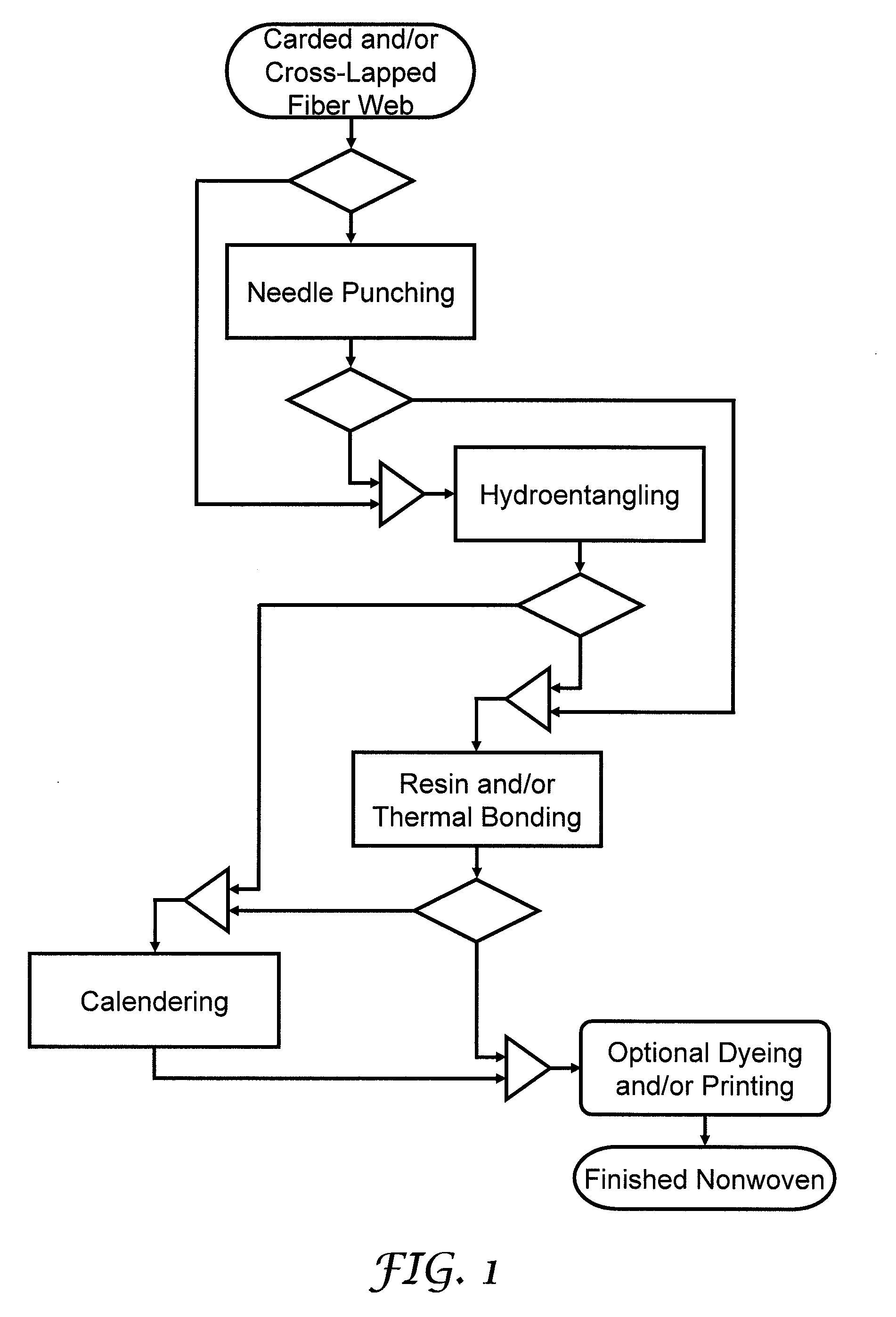Staple fiber durable nonwoven fabrics
- Summary
- Abstract
- Description
- Claims
- Application Information
AI Technical Summary
Benefits of technology
Problems solved by technology
Method used
Image
Examples
examples
[0077]The effect of varying ratios of blended PET and co-PET fibers, varying amounts and types of binder, varying fabric basis weights and several different patterns in finished nonwoven fabrics on the grab tensile strength and the tongue tear strength were measured. Grab tensile strength is a measure of the breaking strength of the fabric and can be measured by the method provided in ASTM D5034. According to ASTM D5034, the fabric sample is placed into a tensile testing machine that grips the fabric with two clamps, and one clamp slowly moves away from the other clamp, which remains stationary. The grab tensile strength is the highest tensile load achieved just before the fabric tears or breaks. Grab tensile strength can be measured in the machine direction and the cross machine direction of the fabric.
[0078]Tongue tear strength is a measure of the force required to continue a rip through the fabric and can be measured by the method provided in ASTM D2261. According to ASTM D2261, ...
examples 1-4
[0079]A nonwoven fabric was prepared with 100 wt % PET fibers (Example 1). Additionally, three nonwoven fabrics were prepared with varying ratios of PET to co-PET fibers˜95:5, 90:10, and 80:20 (Examples 2-4, respectively). Each of the nonwoven fabrics included 3 wt % acrylic binder, had a fabric basis weight of 180 grams per square meter (gsm), and were patterned with a 14 mesh screen as disclosed herein using a hydroentangling drum sleeve. The fabrics having co-PET fibers were thru-air bonded at 200° C. Each of the nonwoven fabric samples were tested for grab tensile strength and tongue tear strength in the longitudinal or machine direction (MD) and in the transverse or cross machine direction (CD) according to the test standards noted herein. The results are set forth in Table 1.
TABLE 13 wt % acrylic binder,thru-air bonded at 200° C.(except 100% PET), 180 gsmbasis weight, 14 mesh patternExamplesComposition / Property1234PET Fibers, wt %100959080Co-PET Fibers, wt %051020MD Grab Tensi...
examples 5-8
[0081]Four nonwoven fabrics were prepared having only PET fibers with 3 wt % acrylic binder included. The nonwoven fabrics had the following fabric basis weights (in gsm) and patterning: 100 / 14 mesh, 130 / 14 mesh, 200 / 14 mesh, and 200 / Herringbone (Examples 5-8, respectively). Each of the nonwoven fabric samples were tested for grab tensile strength and tongue tear strength in the longitudinal or machine direction (MD) and in the transverse or cross machine direction (CD) according to the test standards noted herein. The results are set forth in Table 2.
TABLE 2100 wt % Carded Polyester Fibers,3 wt % Acrylic BinderExamples5678Fabric Basis Weight, gsm100130200200Patterning14 mesh14 mesh14 meshHerringboneMD Grab Tensile Strength,91108170183lbsMD Tongue Tear Strength,3.65.47.27.1lbsCD Grab Tensile Strength, lbs5987141144CD Tongue Tear Strength, lbs5.55.79.27.5
[0082]Increasing fabric basis weight increases the grab tensile strength of the fabrics. However, the improvement in grab tensile s...
PUM
| Property | Measurement | Unit |
|---|---|---|
| Fraction | aaaaa | aaaaa |
| Fraction | aaaaa | aaaaa |
| Percent by mass | aaaaa | aaaaa |
Abstract
Description
Claims
Application Information
 Login to View More
Login to View More - R&D
- Intellectual Property
- Life Sciences
- Materials
- Tech Scout
- Unparalleled Data Quality
- Higher Quality Content
- 60% Fewer Hallucinations
Browse by: Latest US Patents, China's latest patents, Technical Efficacy Thesaurus, Application Domain, Technology Topic, Popular Technical Reports.
© 2025 PatSnap. All rights reserved.Legal|Privacy policy|Modern Slavery Act Transparency Statement|Sitemap|About US| Contact US: help@patsnap.com


